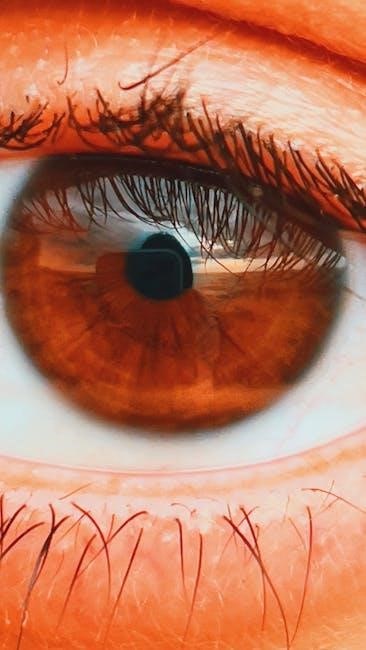
The human face is a complex structure, with facial anatomy playing a crucial role in nonverbal communication. Understanding facial muscles and their functions is essential for fields like psychology, medicine, and animation. The book “Anatomy of Facial Expressions” by Uldis Zarins offers a detailed exploration, combining artistic and medical perspectives to explain how emotions are visually conveyed through muscle movements. This resource is invaluable for anyone seeking to master the intricacies of human emotion and expression.
1.1 Importance of Understanding Facial Anatomy
Understanding facial anatomy is crucial for interpreting nonverbal communication, a cornerstone of human interaction. Facial muscles, intricately linked to emotions, reveal feelings like happiness, sadness, and anger through specific movements. This knowledge is vital in psychology, medicine, and animation, where accurate emotional portrayal is key. The book “Anatomy of Facial Expressions” by Uldis Zarins highlights how artists and medical experts collaborate to detail muscle functions, aiding professionals in mastering emotional expressions. Such insights bridge art and science, enhancing both creative and clinical applications.
1.2 Overview of Facial Muscles and Their Role
Facial muscles are categorized into groups based on their functions, such as the orbital, nasal, and zygomatic muscles. These muscles control expressions by contracting and relaxing, enabling movements like smiling, frowning, or raising eyebrows. Their role is vital for nonverbal communication, conveying emotions and intentions. Understanding their anatomy helps in accurately interpreting and replicating expressions, essential for fields like psychology, animation, and medicine. The book “Anatomy of Facial Expressions” provides detailed insights into these muscles, ensuring a comprehensive grasp of their structure and function.
1.3 Historical Perspectives on Facial Expression Study
The study of facial expressions dates back to early scientific inquiries, with Charles Darwin exploring their evolutionary roots. Historically, theories often lacked a scientific basis, focusing on superficial observations. The work of pioneers like Ekman later introduced universal emotion recognition. Understanding facial anatomy has evolved, blending art and science to reveal the intricate muscle mechanics behind expressions. This historical journey highlights the importance of combining anatomical knowledge with emotional interpretation, as detailed in resources like Uldis Zarins’ “Anatomy of Facial Expressions.”
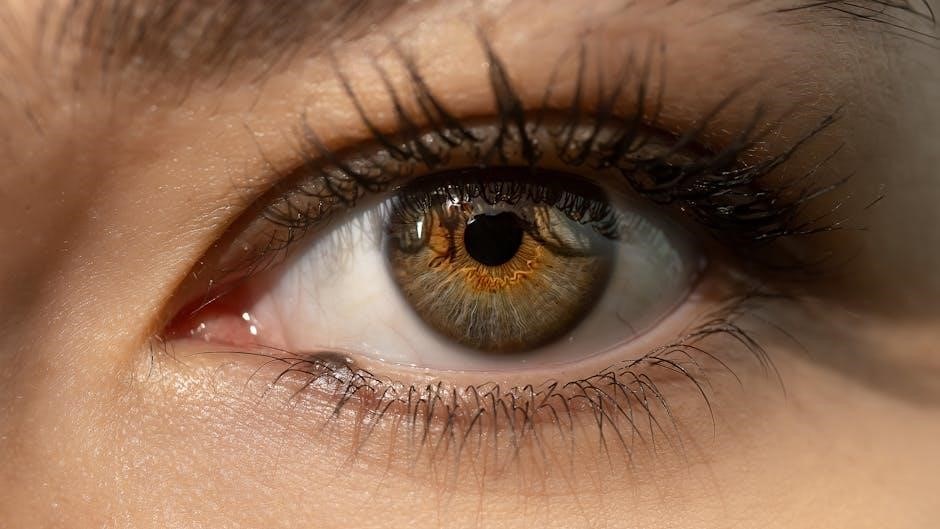
Facial Muscle Structure and Function
Facial muscles are intricately structured, embedded in the superficial fascia, originating from skull bones, and inserting into skin to create diverse expressions. Their coordinated actions enable precise emotional communication, as detailed in resources like Uldis Zarins’ “Anatomy of Facial Expressions.”
2.1 Classification of Facial Muscles
Facial muscles are classified into five main groups: head, orbital, nasal, mouth, and neck. The head group includes scalp muscles, while the orbital group controls eye movements, featuring the orbicularis oculi. The nasal group manages nasal expressions, and the mouth group, with muscles like zygomaticus major and minor, governs smiles and lip movements. The neck group supports facial expressions through muscles like the platysma. This classification aids in understanding the intricate voluntary and involuntary movements that convey emotions, essential for fields like psychology, animation, and medicine.
2.2 Orbicularis Oculi: Function and Anatomy
The orbicularis oculi muscle surrounds the eye, playing a key role in blinking, squinting, and eye closure. It is divided into three layers: orbital, palpebral, and lacrimal. The orbital part controls voluntary movements like squinting, while the palpebral part handles involuntary blinking. The lacrimal part aids tear distribution. This muscle works synergistically with others, such as the corrugator supercilii, to create expressive eye movements. Its anatomy is crucial for understanding facial expressions, as it contributes to emotions like surprise or fear by widening or narrowing the eyes.
2.3 Zygomaticus Major and Minor: Key Expressive Muscles
The zygomaticus major and minor muscles are pivotal in forming facial expressions, particularly those associated with happiness and smiling. The zygomaticus major originates from the zygomatic bone and inserts into the angle of the mouth, pulling it upward and outward to create a smile. The zygomaticus minor, smaller and deeper, connects to the orbicularis oculi, enhancing eye movements during expressions like laughter. Together, they are essential for conveying joy and friendliness, making them central to understanding emotional communication through facial anatomy.
2.4 Buccinator and Its Role in Facial Expressions
The buccinator muscle plays a significant role in facial expressions by compressing the cheeks and aiding in actions like blowing or sucking. Originating from the anterior border of the mandible and inserting into the orbicularis oris, it helps form the shape of the mouth. This muscle is crucial in puckering and other movements, contributing to expressions of contempt or disapproval. Its function is deeply intertwined with emotional communication, making it a key component in understanding facial anatomy and its role in conveying emotions effectively.
Physiology of Facial Expressions
Facial expressions are controlled by neural pathways linking the brain to facial muscles. The nervous system triggers muscle contractions, enabling emotional responses and nonverbal communication through precise movements.
3.1 Neural Control of Facial Muscles
The neural control of facial muscles involves complex pathways between the brain and facial nerves. The facial nerve (VII) primarily regulates voluntary and involuntary muscle movements, enabling precise emotional expressions. Cranial nerves transmit signals from the brainstem to facial muscles, coordinating actions like smiling or frowning. This neural network allows for both conscious and subconscious control, making facial expressions a key component of nonverbal communication. Understanding this system is crucial for fields like psychology and medicine, where interpreting facial cues is essential for diagnosis and interaction.
3.2 Synergistic and Antagonistic Muscle Actions
Facial muscles work in coordination through synergistic and antagonistic actions to produce complex expressions. Synergistic muscles collaborate to enhance movement, like the zygomaticus major and orbicularis oculi working together to create a genuine smile. Conversely, antagonistic muscles oppose each other, such as the procerus and frontalis, which relax while others contract to soften expressions. This interplay allows for subtle emotional cues, essential for communication. Understanding these interactions is vital for accurately interpreting and replicating facial expressions in fields like animation and psychology, where precise muscle control is key to conveying emotion.
3.3 The Role of the Nervous System in Expressions
The nervous system is central to controlling facial expressions, enabling both voluntary and involuntary movements. Cranial nerves, particularly the facial nerve (VII), regulate muscle contractions, allowing precise emotional displays. This neural coordination ensures expressions like smiles or frowns are dynamic and nuanced. Damage to these nerves can impair expression, highlighting their importance. The nervous system’s role is vital for understanding how emotions translate into visible facial cues, making it a cornerstone of studying facial anatomy and its applications in psychology, medicine, and animation.
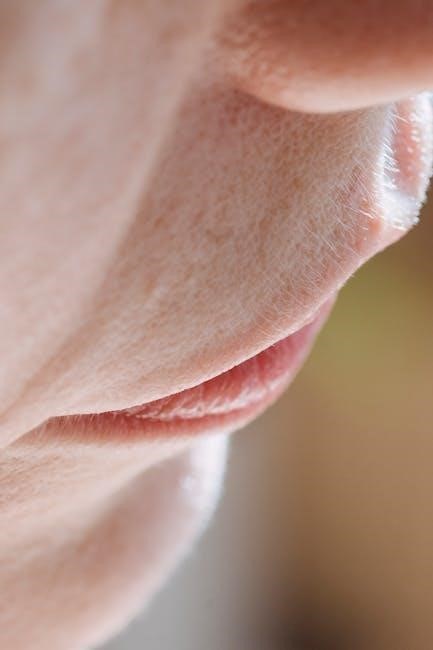
The Six Basic Emotions and Their Expressions
The six basic emotions—happiness, sadness, anger, fear, disgust, and surprise—each correspond to unique facial muscle movements. These expressions are universally recognized, governed by specific muscle activations.
4.1 Happiness: Muscle Movements and Characteristics
Happiness is characterized by distinct muscle movements, primarily involving the zygomaticus major and minor muscles, which lift the cheeks and corners of the mouth. The orbicularis oculi muscles contract, creating crow’s feet around the eyes, while the buccinator muscles aid in forming a wide, genuine smile. This expression is often accompanied by raised eyebrows and a relaxed forehead. The neural control ensures synchronized movement, making happiness one of the most universally recognized and expressive emotions. These muscle activations create a bright, engaging facial display that communicates joy and positivity.
4.2 Sadness: Anatomy of a Frowning Face
Sadness is anatomically characterized by the contraction of specific facial muscles, primarily the corrugator supercilii and procerus, which lower and furrow the eyebrows. The orbicularis oculi muscles cause the eyelids to droop, while the zygomaticus muscles relax, flattening the cheeks. The mouth often forms a frown due to the depressor anguli oris muscle, and the nasolabial folds deepen. This expression reflects emotional distress, with neural signals triggering a coordinated response in these muscles to convey sorrow. The universal recognition of this pattern underscores its evolutionary significance in human communication.
4.3 Anger: Tension in Facial Muscles
Anger manifests through pronounced tension in facial muscles, particularly the corrugator supercilii and procerus, which lower and furrow the eyebrows. The orbicularis oculi muscles tighten, narrowing the eyes, while the nasalis muscles flare the nostrils. The zygomaticus muscles may tense, pulling the cheeks upward, and the mentalis muscle can create dimpling in the chin. The lips often press together or form a straight line, and jaw clenching occurs due to masseter muscle activation. This coordinated muscle activity reflects the body’s “fight-or-flight” response, with neural signals triggering a rigid, confrontational expression to convey intense emotional arousal.
4.4 Fear: Wide-Eyed Expressions Explained
Fear triggers a distinct facial response, characterized by wide-eyed expressions. The orbicularis oculi muscles relax, causing the eyelids to open fully, while the frontalis muscle raises the eyebrows. This results in a startled appearance, with visible sclera above and below the iris. The zygomaticus muscles are inhibited, reducing cheek movement. The lips may thin or part slightly, and the mouth may open. This expression is linked to the body’s “fight-or-flight” response, amplifying the visibility of the eyes to process potential threats, making the face appear more expressive and alert to convey distress or alarm.
4.5 Disgust: Nasal and Mouth Movements
The expression of disgust involves pronounced nasal and mouth movements. The levator labii superioris muscle elevates the upper lip, while the nasalis muscle causes the nose to wrinkle and flare. The zygomaticus minor muscle may assist in drawing the cheek upward, contributing to the scrunched facial appearance. The mouth often forms an “O” shape, with the orbicularis oris muscle puckering the lips. This expression is often accompanied by raised eyebrows and tensed eyelids, creating a look of distaste or aversion. The combination of these movements creates a distinctive, unpleasant facial expression tied to feelings of revulsion or rejection.
4.6 Surprise: The Anatomy of a Startled Face
The expression of surprise is characterized by wide, open eyes and a dropped jaw. The orbicularis oculi muscles relax, allowing the eyelids to widen, while the frontalis muscle raises the eyebrows. The zygomaticus major and minor muscles may slightly pull the corners of the mouth upward, though the mouth often remains open. The orbicularis oris muscle relaxes, causing the lips to part. This expression is controlled by the facial nerve, particularly the temporal and zygomatic branches. Surprise is a universal signal of astonishment or sudden reaction, showcasing the face’s ability to convey intense emotional responses instantly.
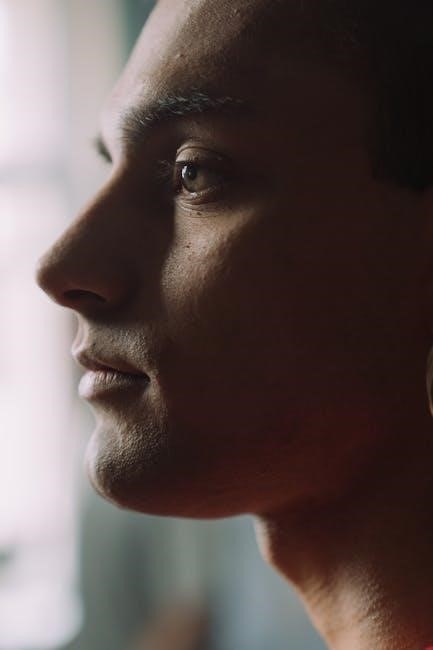
Advanced Topics in Facial Expression Anatomy
Exploring intricate facial muscle coordination and subtle expression variations. Advanced topics include detailed eyebrow movements, lip dynamics, and forehead muscle interactions, essential for realistic expression mapping in art and science.
5.1 The Subtle Differences in Eyebrow Movements
Eyebrow movements are a critical component of facial expressions, conveying emotions like surprise, fear, and skepticism. The frontalis muscle controls eyebrow elevation, while the corrugators cause furrowing. Subtle variations, such as asymmetrical raises or slight furrows, can significantly alter emotional interpretation. These movements are often universal across cultures, making them a key focus in understanding nonverbal communication. The interplay of eyebrow positioning with other facial muscles, like the orbicularis oculi, enhances expressiveness. Studying these nuances is essential for accurately interpreting and replicating facial expressions in fields such as psychology, animation, and art.
5.2 Lip Movements and Their Emotional Significance
Lip movements are a vital aspect of facial expressions, primarily controlled by the orbicularis oris muscle. This muscle enables actions like puckering, smiling, or pursing, each conveying distinct emotions. For instance, a smile signals happiness, while a tense lip may indicate fear or anxiety. The lips’ flexibility allows subtle emotional cues, making them a focal point in nonverbal communication. Understanding these movements is crucial for accurately interpreting expressions in psychology, animation, and art, as highlighted in resources like Uldis Zarins’ work on facial anatomy.
5.3 The Role of theForehead in Expressions
5.3 The Role of the Forehead in Expressions
The forehead plays a significant role in conveying emotions through its muscle movements, primarily controlled by the frontalis muscle. This muscle allows for raising or lowering the eyebrows, which can express surprise, concern, or skepticism. The forehead’s ability to crease and relax adds depth to facial expressions, enhancing nonverbal communication. Its interplay with eyebrow movements and other facial muscles makes it a key element in understanding emotional states, as detailed in studies and anatomical guides on facial expressions.

Applications of Facial Anatomy Knowledge
Facial anatomy knowledge is vital in psychology for understanding emotions, in medicine for reconstructive surgery, and in animation for creating realistic characters. It also aids law enforcement in reading suspects, enhancing nonverbal communication insights across diverse fields.
6.1 In Psychology: Understanding Nonverbal Cues
Facial anatomy is crucial in psychology for decoding nonverbal cues, as emotions are often conveyed through subtle muscle movements. By studying facial expressions, psychologists can identify emotional states like happiness, sadness, or anger. The book “Anatomy of Facial Expressions” provides detailed insights into how facial muscles function, enabling professionals to interpret these cues accurately. This knowledge enhances emotional intelligence, aiding in fields such as behavioral analysis, counseling, and social interactions. Understanding facial anatomy bridges the gap between physical expressions and emotional experiences, offering a deeper insight into human communication and behavior.
6.2 In Medicine: Facial Reconstructive Surgery
Facial anatomy is vital in reconstructive surgery, where understanding muscle structure and function is critical for restoring both form and function. Surgeons rely on detailed knowledge of facial muscles to repair damaged tissues, ensuring natural expressions post-surgery. The “Anatomy of Facial Expressions” provides comprehensive insights, aiding in precise reconstruction. This expertise helps patients regain emotional expression and aesthetic harmony, highlighting the significance of anatomical accuracy in medical procedures.
6.3 In Animation: Creating Realistic Characters
Facial anatomy expertise is crucial for animators to craft believable characters. “Anatomy of Facial Expressions” offers detailed muscle mappings, enabling realistic emotion portrayal. Artists use this knowledge to design characters with lifelike expressions, enhancing storytelling impact. Accurate anatomical understanding ensures animations resonate emotionally with audiences, making it indispensable for creating authentic, engaging character designs in film and gaming.
6.4 In Law Enforcement: Reading Suspects
Understanding facial anatomy aids law enforcement in interpreting nonverbal cues. Officers trained in facial expression analysis can detect deception or stress by identifying specific muscle movements. This skill enhances interrogation techniques and threat assessment, helping officers make informed decisions. The insights from “Anatomy of Facial Expressions” provide a scientific foundation for reading suspects’ emotions, improving situational awareness and public safety. This application bridges psychology and security, offering practical tools for real-world scenarios.
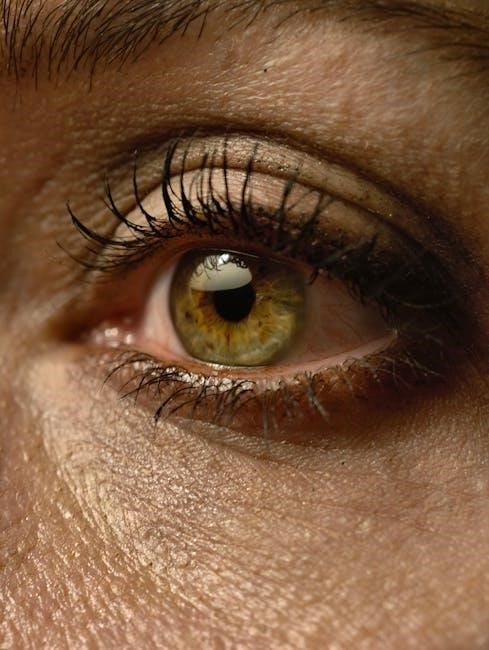
Cultural and Individual Variations
Cultural and individual differences significantly influence facial expressions. While some emotions are universal, cultural norms shape their display. Individual facial anatomy and personal experiences also create unique expression patterns, making each face distinct. The book “Anatomy of Facial Expressions” explores these variations, providing insights into how diverse backgrounds and anatomical structures affect nonverbal communication.
7.1 Universal vs. Culture-Specific Expressions
The book Anatomy of Facial Expressions explores the interplay between universal and culture-specific facial expressions. While basic emotions like happiness, sadness, and fear are universally recognized, cultural norms often dictate their intensity and social acceptability. For instance, certain cultures may encourage restrained expressions, while others promote overt emotional displays. This duality highlights how facial anatomy serves as a universal canvas for emotion, while cultural conditioning paints the final picture. Understanding these variations is crucial for interpreting nonverbal cues accurately across diverse populations.
7.2 Individual Differences in Facial Anatomy
Individual differences in facial anatomy significantly influence how emotions are expressed. Variations in muscle structure, bone formation, and skin elasticity contribute to unique facial landscapes. The book Anatomy of Facial Expressions highlights how these differences affect the subtlety and intensity of expressions. For instance, some individuals may have more pronounced facial muscles, leading to more dynamic expressions, while others may exhibit finer, more subdued movements. Understanding these variations is crucial for artists, psychologists, and surgeons aiming to accurately interpret or replicate facial expressions. The book provides a comprehensive guide to these individual nuances.
7.3 Age-Related Changes in Facial Muscles
Age-related changes in facial muscles significantly alter emotional expressions. As people age, facial muscles lose mass and elasticity, reducing the intensity of expressions. The orbicularis oculi and zygomaticus muscles weaken, making smiles and frowns less pronounced. Skin sagging and fat redistribution further soften facial contours. These changes impact how emotions are perceived, with older faces often appearing more neutral. The book Anatomy of Facial Expressions explores these transformations, offering insights into how aging affects nonverbal communication and facial aesthetics. Understanding these changes is vital for fields like cosmetics and plastic surgery.
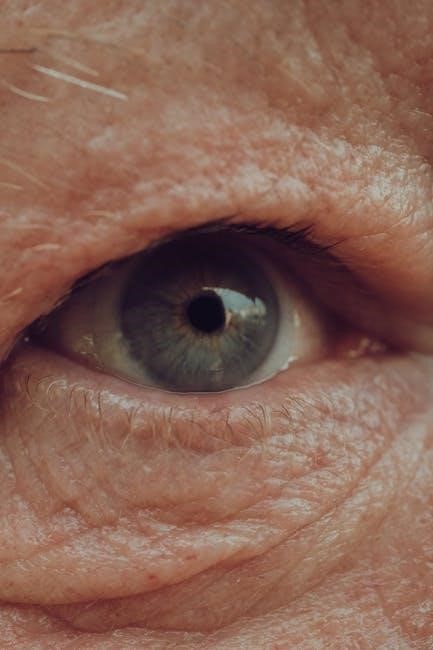
The Book “Anatomy of Facial Expressions”
“Anatomy of Facial Expressions” by Uldis Zarins is a groundbreaking resource that combines artistic and medical expertise to detail facial anatomy and its role in emotion. The book features color-coded 3D models and live subject images, providing a comprehensive understanding of facial muscles and their functions. It is an essential tool for artists, medical professionals, and anyone seeking to master the intricacies of human expression;
8.1 Author Uldis Zarins and His Contributions
Uldis Zarins, a renowned expert in facial anatomy, has made significant contributions to the field through his detailed and accessible work. His book, “Anatomy of Facial Expressions”, bridges the gap between art and science by providing a comprehensive understanding of facial muscles and their roles in emotion. Zarins’ collaboration with medical experts and artists ensures the content is both accurate and visually engaging, making it an invaluable resource for professionals and enthusiasts alike. His work has redefined how facial anatomy is studied and applied across various disciplines.
8.2 Key Features of the Book
“Anatomy of Facial Expressions” stands out for its detailed, visually oriented approach. The book features color-coded 3D models and live images of facial muscles, providing clarity on their structure and function. It includes in-depth explanations of facial anatomy and physiology, making it a valuable resource for both professionals and students. The collaboration between artists and medical experts ensures accuracy and practical applications. The book’s content is supported by real-world examples, enhancing its usability in fields like psychology, animation, and medicine. Its comprehensive yet accessible design makes it a must-have for understanding facial expressions.
8.3 Target Audience and Use Cases
“Anatomy of Facial Expressions” is designed for a diverse audience, including artists, animators, psychologists, and medical professionals. It serves as a practical guide for art students aiming to master facial anatomy for realistic portraiture. Surgeons and cosmetic professionals benefit from its detailed insights into facial muscle structure and aging processes. Additionally, animators and game designers can use it to create lifelike characters. The book also appeals to law enforcement for interpreting nonverbal cues, making it a versatile resource across multiple disciplines. Its interdisciplinary approach ensures wide applicability and value.
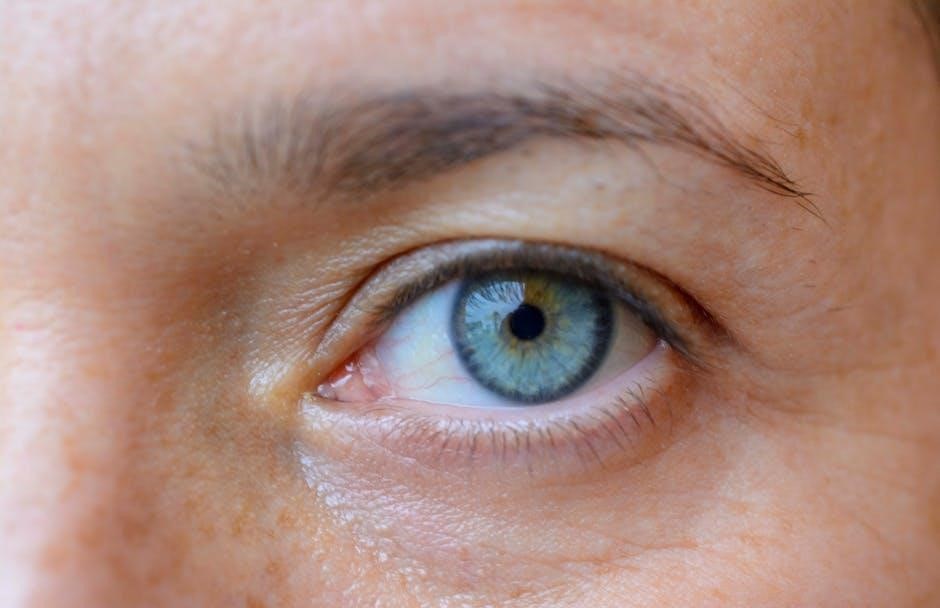
Evolution of Facial Expressions
Facial expressions have evolved to serve adaptive functions, with Darwin’s theory highlighting their role in communication and survival. Modern studies explore how these traits have developed across species.
9.1 Darwin’s Theory of Evolution in Expressions
Charles Darwin’s groundbreaking work on evolution introduced the concept that facial expressions are universal and innate, shaped by natural selection to convey emotions vital for survival and social interaction. His theory, detailed in The Expression of the Emotions in Man and Animals, posits that certain expressions, like fear or anger, are consistent across cultures due to shared evolutionary origins. This idea forms the foundation for modern studies on the biological basis of facial communication, linking anatomy to emotional expression and adaptive behaviors.
9.2 Adaptive Functions of Facial Expressions
Facial expressions serve as vital adaptive tools, enabling individuals to communicate emotions and intentions effectively. These expressions, such as fear, anger, happiness, sadness, disgust, and surprise, have evolved to convey specific signals that aid in survival and social interaction. For instance, a fearful expression can alert others to potential danger, while a smile may signal friendliness and foster cooperation. The book Anatomy of Facial Expressions explores how these expressions are deeply rooted in evolutionary biology, highlighting their universal nature and role in human and animal behavior. Understanding these adaptive functions provides insight into the biological basis of nonverbal communication.
9.3 Modern Studies on Evolutionary Aspects
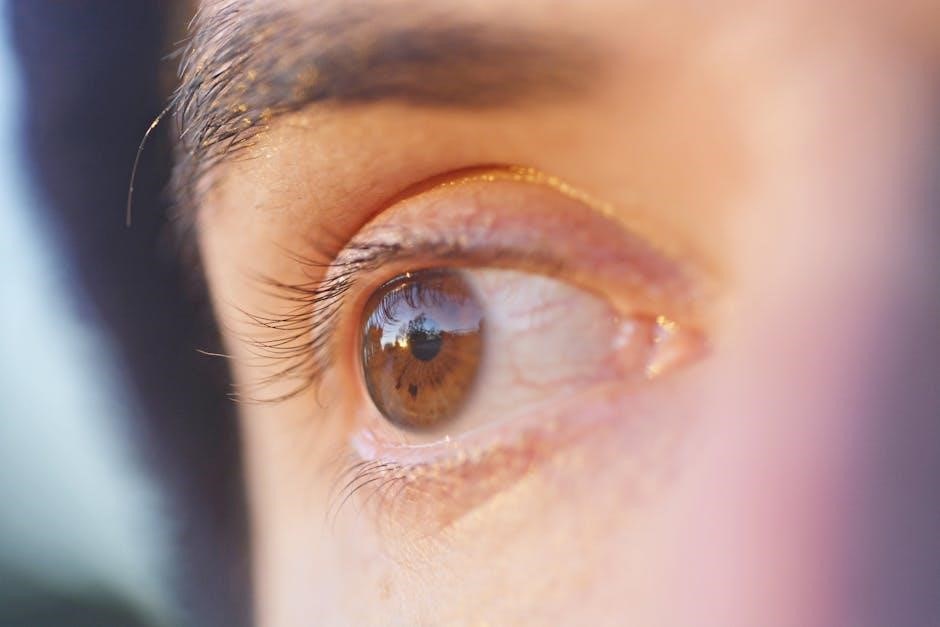
Modern research continues to uncover the evolutionary roots of facial expressions, building on Darwin’s foundational work. Studies using advanced imaging and cross-cultural analysis reveal that certain expressions, like surprise and fear, are universally recognized, suggesting an innate biological basis; The book Anatomy of Facial Expressions discusses how these findings support the idea that facial muscles evolved to convey specific emotional signals, essential for survival and social bonding. Such insights bridge the gap between anatomy and evolutionary psychology, offering a comprehensive understanding of how human faces communicate emotion across cultures and time.
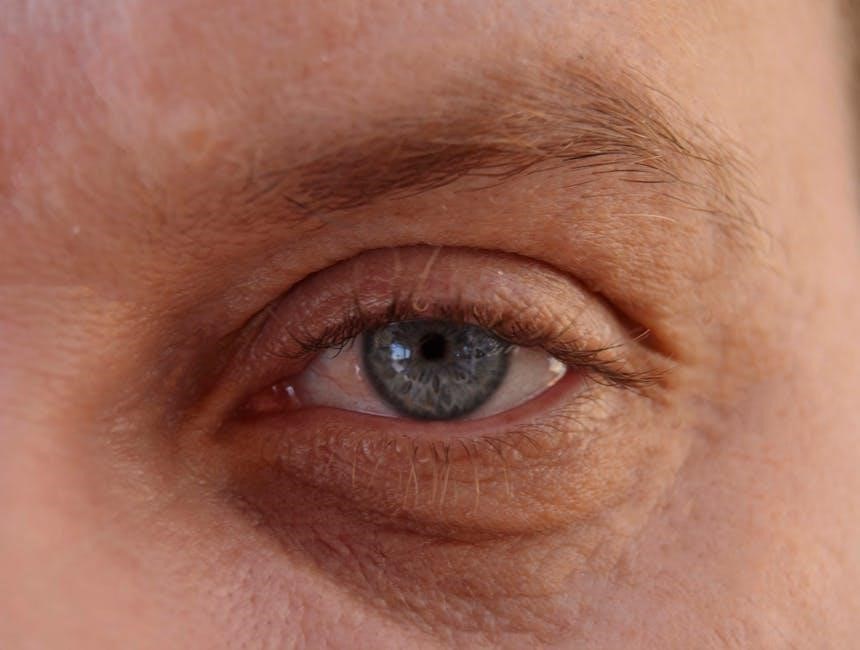
Digital Resources and Tools
Digital resources like 3D models and interactive platforms provide detailed insights into facial anatomy. PDF guides and eBooks offer comprehensive studies, aiding professionals and learners in understanding facial expressions and anatomy.
10.1 3D Models for Studying Facial Anatomy
3D models are revolutionary tools for exploring facial anatomy, offering detailed, interactive visuals of facial muscles and structures. These models enable users to examine how muscles interact during expressions, providing a deeper understanding of facial mechanics. Color-coded 3D images in resources like “Anatomy of Facial Expressions” highlight muscle layers, making complex anatomy accessible. Artists, surgeons, and students benefit from these models, as they allow precise study of facial movements and their emotional significance. Such tools bridge the gap between theory and practice, enhancing learning and application in various fields.
10.2 PDF Guides and eBooks on the Topic
PDF guides and eBooks on facial anatomy are invaluable resources for detailed study. “Anatomy of Facial Expressions” by Uldis Zarins is a standout, offering comprehensive insights into facial muscles and their roles in emotion. These guides often include color-coded 3D models and live images, making complex anatomy accessible. eBooks provide portability and accessibility, allowing learners to study facial structures anywhere. Many platforms offer free or paid downloads, catering to artists, surgeons, and researchers. These resources are essential for mastering the intricacies of facial anatomy and its applications in various fields.
10.3 Interactive Learning Platforms
Interactive learning platforms revolutionize the study of facial anatomy by offering engaging tools. These platforms feature 3D models, allowing users to explore facial muscles in depth. Quizzes and simulations enhance understanding, making learning dynamic. Many platforms integrate real-time animations to demonstrate muscle movements during expressions. These resources are particularly beneficial for artists, animators, and medical students, providing immersive experiences. They also offer personalized learning paths and tracking progress, ensuring a comprehensive grasp of facial anatomy and its role in emotional expressions. These platforms bridge education and technology, creating a captivating environment for learners.
The study of facial anatomy is crucial for understanding human emotions and expressions. Uldis Zarins’ work provides a comprehensive guide, blending art and science for diverse applications, from animation to medicine.
11.1 Summary of Key Points
The anatomy of facial expressions is a intricate field combining art and science. Uldis Zarins’ work highlights the importance of understanding facial muscles and their roles in emotion. Key points include the classification of facial muscles, their physiological functions, and how they contribute to universal and culture-specific expressions. The book emphasizes the collaboration between artists and medical experts, offering detailed visuals and practical insights. It serves as a vital resource for professionals in psychology, medicine, animation, and law enforcement, providing a foundation for mastering facial anatomy and its applications.
11.2 Future Directions in Facial Anatomy Study
Future research in facial anatomy should focus on integrating advanced technologies like 3D modeling and AI to enhance understanding of muscle dynamics. Collaborations between artists, psychologists, and medical experts will deepen insights into emotional expression. Digital tools, such as interactive learning platforms, will make complex anatomy accessible to broader audiences. Additionally, cultural and individual variations in facial structures should be explored to create more inclusive models. These advancements promise to revolutionize fields from animation to psychology, fostering a more comprehensive understanding of human communication.